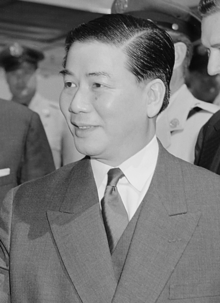
Back محاولة الانقلاب في جنوب فيتنام عام 1960 Arabic Intent de cop d'estat a Vietnam del Sud de 1960 Catalan Militärputsch in Südvietnam 1960 German Golpe de Estado en Vietnam del Sur de 1960 Spanish 1960. aasta Lõuna-Vietnami riigipöördekatse ET Tentative de coup d'État de 1960 en république du Viêt Nam French Upaya kudeta Vietnam Selatan 1960 ID 1960年ベトナム共和国の軍事クーデター未遂 Japanese 1960년 베트남 공화국 쿠데타 시도 Korean Golpe de Estado no Vietnã do Sul em 1960 Portuguese
| 1960 South Vietnamese coup attempt | |||||||
|---|---|---|---|---|---|---|---|
| Part of the War in Vietnam (1959–1963) in the Vietnam War | |||||||
 President Ngô Đình Diệm of South Vietnam | |||||||
| |||||||
| Belligerents | |||||||
|
|
| ||||||
| Commanders and leaders | |||||||
|
|
| ||||||
| Strength | |||||||
|
|
| ||||||
| Casualties and losses | |||||||
| Unclear, more than 400 dead on both sides | |||||||
| History of Ho Chi Minh City |
|---|
 |
| Metro • Names (district names) • Organised crime |
|
|
On 11 November 1960, a failed coup attempt against President Ngô Đình Diệm of South Vietnam was led by Lieutenant Colonel Vương Văn Đông and Colonel Nguyễn Chánh Thi of the Airborne Division of the Army of the Republic of Vietnam (ARVN).
The rebels launched the coup in response to Diệm's autocratic rule and the negative political influence of his brother Ngô Đình Nhu and sister-in-law Madame Nhu. They also bemoaned the politicisation of the military, whereby regime loyalists who were members of the Ngô family's covert Cần Lao Party were readily promoted ahead of more competent officers who were not insiders. Đông was supported in the conspiracy by his brother-in-law Lieutenant Colonel Nguyen Trieu Hong, whose uncle was a prominent official in a minor opposition party. The main link in the coup was Đông's commanding officer Thi, whom he persuaded to join the plot.
The coup caught the Ngô family completely off-guard, but was also chaotically executed. The plotters neglected to seal the roads leading into the capital Saigon to seal off loyalist reinforcements, and they hesitated after gaining the initiative. After initially being trapped inside the Independence Palace, Diệm stalled the coup by holding negotiations and promising reforms, such as the inclusion of military officers in the administration. In the meantime, opposition politicians joined the fray, trying to exploit Diệm's position. However, the president's real aim was to buy time for loyalist forces to enter the capital and relieve him. The coup failed when the 5th and 7th Divisions of the ARVN entered Saigon and defeated the rebels. More than four hundred people—many of whom were civilian spectators—were killed in the ensuing battle. These included a group of anti-Diệm civilians who charged across the palace walls at Thi's urging and were cut down by loyalist gunfire.
Đông and Thi fled to Cambodia, while Diệm berated the United States for a perceived lack of support during the crisis. Afterwards, Diệm ordered a crackdown, imprisoning numerous anti-government critics and former cabinet ministers. Those that assisted Diệm were duly promoted, while those that did not were demoted. A trial for those implicated in the plot was held in 1963. Seven officers and two civilians were sentenced to death in absentia, while 14 officers and 34 civilians were jailed. Diệm's regime also accused the Americans of sending Central Intelligence Agency members to assist the failed plot. When Diệm was assassinated after a 1963 coup, those jailed after the 1960 revolt were released by the new military junta.